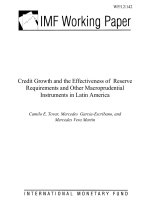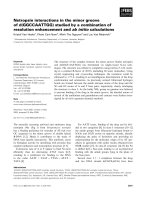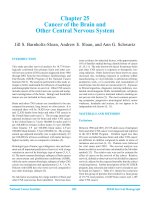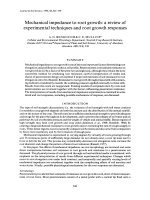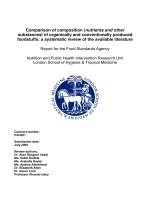The Exploitation of Natural Resources of the Moon and Other Celestial Bodies pot
Bạn đang xem bản rút gọn của tài liệu. Xem và tải ngay bản đầy đủ của tài liệu tại đây (3.35 MB, 401 trang )
e Exploitation of Natural Resources of
the Moon and Other Celestial Bodies
Studies in Space Law
General Editor
F.G. von der Dunk
University of Nebraska, College of Law, Space and
Telecommunications Law Program
Editorial Board
E. Back Impallomeni, University of Padua
S. Freeland, University of Western Sydney
J. Gabrynowicz, National Remote Sensing & Space Law Center,
University of Mississippi
S. Hobe, University of Cologne
R. Jakhu, Institute of Air and Space Law, McGill University
F. L yall, University of Aberdeen
V.S. Mani, Gujarat University
K.U. Schrogl, German Aerospace Center DLR
L.J. Smith, University of Bremen
VOLUME 4
e Exploitation of Natural
Resources of the Moon and
Other Celestial Bodies
A Proposal for a Legal Regime
By
Fabio Tronchetti
LEIDEN • BOSTON
2009
is book is printed on acid-free paper.
Library of Congress Cataloging-in-Publication Data
Tronchetti, Fabio.
e exploitation of natural resources of the moon and other celestial bodies : a proposal
for a legal regime / by Fabio Tronchetti.
p. cm. (Studies in space law ; v. 4)
Includes bibliographical references and index.
ISBN 978-90-04-17535-8 (hardback : alk. paper) 1. Space mining Law and legislation.
2. Natural resources Law and legislation. 3. Moon International status. I. Title.
KZD3491.5.T76 2009
341.4’7 dc22
2009029668
ISSN 1871-7659
ISBN 978 90 04 17535 8
Copyright 2009 by Koninklijke Brill NV, Leiden, e Netherlands.
Koninklijke Brill NV incorporates the imprints Brill, Hotei Publishing,
IDC Publishers, Martinus Nijhoff Publishers and VSP.
All rights reserved. No part of this publication may be reproduced, translated, stored in
a retrieval system, or transmitted in any form or by any means, electronic, mechanical,
photocopying, re cording or ot herwise, w ithout pr ior w ritten p ermission f rom t he
publisher.
Authorization to photocopy items for internal or personal use is granted by Koninklijke
Brill NV provided that the appropriate fees are paid directly to e Copyright Clearance
Center, 222 Rosewood Drive, Suite 910, Danvers, MA 01923, USA.
Fees are subject to change.
pr inted in the ne ther l ands
To the ever lasting memory of my beloved grandfather Fabio and
grandmother Alba
For their love and example
“ e Sanskrit word for “action” is “karma”, derived from the root
“kri” which means “to do”.
One does action and gets remunerated for it, in turn transferring
this remuneration to others for work done by them.
us, fruit has arisen out of action, and action out of fruit.
From time immemorial, life has been conducted in this manner.
is is called the wheel of karma.
To act with the motive of gaining fruits is to invite bondage.
Relinquishing the fruits frees us from all miseries.”
Sri Swami Rama, Himalayan master
Contents
Acknowledgments xv
Abbreviations xvii
Chapter 1. Introduction 1
1.1. e exploitation of natural resources of the Moon
and other celestial bodies: a new opportunity of
development for mankind 1
1.2. Space law and the natural resources of the Moon
and other celestial bodies: the need for a legal
regime 3
1.3. e natural resources of the Moon and other
celestial bodies 5
1.4. Overview of the analytical framework 6
Chapter 2. e Outer Space Treaty, the Moon Agreement and
the 1996 Declaration on Space Benefi ts 9
2.1. Introduction 9
2.1.1. e background to the discussion on the
legal status of outer space 9
2.1.2. Legal scholars and the status of outer
space 10
2.1.3. e United Nations and outer space:
defi ning the legal status of outer space
in the period 1958–1966 14
2.2. e Outer Space Treaty 18
2.2.1. Background and importance of the Outer
Space Treaty 18
2.2.2. Article I of the Outer Space Treaty 20
2.2.3. e principle of freedom of exploration
and use 21
viii Contents
2.2.4. e principle of the exploration and use
of outer space for the benefi t and in
the interest of all countries, and the
‘province of all mankind’ concept 23
2.2.5. Article II of the Outer Space Treaty 26
2.2.6. e application of the ‘non-appropriation’
principle to private operators and outer
space resources 29
2.2.7. Articles VI and VII of the Outer
Space Treaty 33
2.3. e Moon Agreement 38
2.3.1. Background and importance of the Moon
Agreement 38
2.3.2. e 1979 Moon Agreement and the Outer
Space Treaty 41
2.3.3. e ‘Common Heritage of Mankind’
concept and the natural resources
of the Moon 45
2.4. e 1996 UNGA Declaration on
S pace Benefi ts 61
2.4.1. I ntroduction 61
2.4.2. e roots of the 1996 Declaration on
S pace Benefi ts: the developing States’
interpretation of Article I of the
Outer Space Treaty 62
2.4.3. e dra ing history of the 1996
Declaration on Space Benefi ts 65
2.4.4. e 1996 Declaration on Space Benefi ts 77
2.4.5. Conclusion: what is the value of the
1996 Declaration on Space Benefi ts? 78
2.5. Conclusion 81
Chapter 3. e Common Heritage of Mankind 85
3.1. Introduction 85
3.2. e ‘Common Heritage of Mankind’: a new way
for managing common areas beyond national
jurisdiction 87
3.3. e origin and evolution of the ‘Common Heritage
of Mankind’ concept 91
Contents ix
3.3.1. Introduction 91
3.3.2. From 1967 to 1971 92
3.3.3. 1972–1974: new elements in the ‘Common
Heritage of Mankind’ concept 98
3.3.4. 1975–1979: further development of the
‘Common Heritage of Mankind’
concept 99
3.3.5. e 1980’s: the decline of the ‘Common
Heritage of Mankind’ concept 104
3.3.6. 1980–1982: the failure of the 1982
Law of the Sea Convention 104
3.3.7. e 1990’s: a second chance for
the ‘Common Heritage of Mankind’ 110
3.3.8. e 1994 Implementation Agreement 116
3.3.9. e ‘Common Heritage of Mankind’ and
the Moon Agreement 118
3.3.10. e emergence of a new interpretation of
the ‘Common Heritage of Mankind’
concept 123
3.4. e legal status of the ‘Common Heritage of
Mankind’ concept: ‘Mankind’ as a new
subject of international law? 126
3.5. Conclusion 129
Chapter 4. e management of international areas and their
limited natural resources: the examples of
Antarctica and ITU 131
4.1. Introduction 131
4.2. Antarctica 132
4.2.1. e origins of the Antarctic Treaty
System 132
4.2.2. e road to the Antarctic Treaty 134
4.2.3. e 1959 Antarctic Treaty 136
4.2.4. e Antarctic Treaty and the Outer
Space Treaty 139
4.2.5. e Convention on the Regulation of
Antarctic Mineral Resources 141
4.2.6. e Protocol on Environmental Protection
to the Antarctic Treaty 155
x Contents
4.2.7. e Convention on the Regulation of the
Antarctic Natural Resources: a lesson for
the extraterrestrial resources regime? 159
4.3. e geostationary orbit 163
4.3.1. Exploiting the geostationary orbit 163
4.3.2. e geostationary orbit and the frequency
spectrum as limited natural resources? 164
4.3.3. e allocation system of the orbit/
spectrum resource 168
4.3.4. e limits and problems of the current
methods of orbit/spectrum allocation 182
4.3.5. e ITU procedures for the management
and allocation of the orbit/spectrum
resource: a valuable example for the
extraterrestrial resources regime? 187
Chapter 5. Property rights in outer space: a crucial issue in the
wake of the commercialisation of outer space and
its resources 193
5.1. I ntroduction 193
5.2. Immovable and movable property rights
in outer space 196
5.3. e myth of immovable property rights in outer
space: some preliminary considerations 197
5.3.1. e non-appropriative nature of outer space:
rejecting claims to immovable property
rights in outer space 198
5.3.2. Private claims of ownership and immovable
property rights over the Moon and other
celestial bodies 202
5.3.3. Individual claims of the Moon and market
of extraterrestrial properties: the example
of Lunar Embassy and the case of Nemitz
versus the United States 203
5.3.4. Space commercialization versus the non-
appropriation principle: the issue of
property rights over natural
resources in outer space 211
5.3.5. Conclusion 217
Contents xi
5.4. Movable property rights in outer space: the legal
regime governing extraterrestrial natural
resources 218
5.4.1. Resource appropriation and use under the
Outer Space Treaty 220
5.4.2. Resource appropriation and use under the
Moon Agreement 225
5.5. Conclusion 231
Chapter 6. Elements of a legal regime to govern the commercial
exploitation of extraterrestrial resources 233
6.1. Introduction: is there a need for a dedicated
legal regime? 233
6.2. Underlying foundations of the legal
regime required 238
6.3. General characteristics of the legal
regime required 241
6.4. Legal nature of the legal regime required:
towards an international agreement 242
6.5. Purpose and main principles of the proposed
Agreement 244
6.6. e institutional part of the Agreement 246
6.6.1. e International Space Authority 246
6.6.2. Characteristics of the International
Space Authority 246
6.6.3. e Assembly 247
6.6.4. e Council 249
6.6.5. Membership of and decision-making in
the Council 250
6.6.6. e Technical and Legal Committee 252
6.6.7. Financing the Authority 253
6.7. e exploitation of lunar resources: applicable
rules and licensing procedure 254
6.7.1. e exploration of the lunar and other celestial
bodies’ surface: general considerations 254
6.7.2. Legal aspects of the exploration phase 255
6.7.3. e application procedure 257
6.7.4. e submission of an exploitative
working plan 257
xii Contents
6.7.5. Review of the plan 259
6.7.6. e license 260
6.8. e liability regime applicable to the exploitation
of extraterrestrial resources 263
6.8.1. e Liability Convention and the
exploitation of lunar and other
celestial bodies’ resources 264
6.8.2. Liability for damage caused to the space
environment 267
6.9. e proposed dispute settlement mechanism 269
6.9.1. e need for a dispute settlement
mechanism: general introduction 269
6.9.2. e WTO dispute settlement mechanism:
general aspects 272
6.9.3. e procedure for the settlement
of disputes 274
6.9.4. First stage 274
6.9.5. Second stage 275
6.9.6. ird stage 277
6.9.7. Appeal 277
6.9.8. A er the DSB ruling 278
6.10. e dispute settlement mechanism of the
proposed legal regime 278
6.11. e exploitation of lunar resources for the benefi t
of all mankind 281
Chapter 7. Conclusion 287
annexes
Annex 1. Dra International Agreement on the exploitation
of natural resources of the Moon and other
celestial bodies 293
Annex 2. Treaty on Principles Governing the Activities of States
in the Exploration and Use of Outer Space, including
the Moon and Other Celestial Bodies 311
Contents xiii
Annex 3. Convention on International Liability for Damage
Caused by Space Objects 319
Annex 4. Convention on Registration of Objects Launched into
Outer Space 331
Annex 5. Agreement Governing the Activities of States on the
Moon and Other Celestial Bodies 337
Annex 6. 1962 (XVIII). Declaration of Legal Principles
Governing the Activities of States in the
Exploration and Use of Outer Space 349
Legal documents 353
Treaties and conventions 353
Declarations, principles and documents 355
Case Law 359
Bibliography 361
Books 361
Ar ticles 365
Internet and web-based sources 378
Index 379
Acknowledgments
is book is a revised and enhanced version of my doctoral thesis, which
I successfully defended at Leiden University on 18 December 2008.
As it has been said many times before, writing a PhD is a lonely and
hard job. e hours I sp ent in the lib rary looking for materials and at
home on the PhD manuscript are countless.
Numerous p ersons ha ve co ntributed t o the p rocess of writing and
fi nalising this book; I am much indebted to them for these contributions
and helping me with my research.
Firstly, I had the ho nor t o b e guide d a nd su pervised b y P rofessor
Frans von der Dunk. He always represented a support and a s ource of
scientifi c inspiration. His co mments a nd ad vices have co ntributed t o
signifi cantly enhance the quality of this book.
Secondly, I am thankful to Professor Elisabeth Back Impallomeni and
to Professor Henri Wassenbergh, for their comments to and remarks on
my PhD ma nuscript. A sp ecial tha nks als o goes t o Professor I sabella
Castangia, my fi rst mentor in the early years of my research in Italy.
I would like to express my gratitude to my mother Marilena for the
love she has shown my whole life. No amount of thanks will ever come
to being suffi cient. My love goes to my sister Silvia, her husband Marcello,
my nephews Ricca rdo and Chiara, my cousins Luigi and S imone, my
aunt Maria Teresa, my father Carlo. A special thank goes to the Arnold
family for their unconditioned love. Last, but of course not the least, my
Kinga. is book would have never seen the light of day without you.
Fabio Tronchetti
Leiden, July 2009
Abbreviations
CHM Common Heritage of Mankind
COPUOS Committee on the Peaceful Uses of
Ou ter Space
DBS Direct Broadcasting Satellites
DSB Dispute Settlement Body
ESA E uropean Space Agency
GATT General Agreement on Tariff s and Trade
GSO Geostationary (Earth) Orbit
IAF I nternational Astronautical Federatio
ICAO International Civil Aviation Organization
ICNT Informal Composite Negotiation Text
ICJ International Court of Justice
IFRB International Frequency Registration Board
IGY I nternational Geophysical Year
IISL International Institute of Space Law
ILA I nternational Law Association
ILC International Law Commission
ILM International Legal Materials
INTELSAT International Telecommunication Satellite
Or ganization
ITU Interntional Telecommunication Union
LRO Lunar Reconnaisance Orbiter
NASA (US) National Astronautics and Space
A dministration
NIEO New International Economic Order
OST Outer Space Treaty
PCIJ Permanent Court of International Justice
UK U nited Kingdom
UN U nited Nations
xviii Abbreviations
UNCLOS United Nations Convention on
the Law of the Sea
UNESCO United Nations Educational, Scientifi c and
C ultural Organization
UNGA United Nations General Assembly
UNISPACE United Nations Conference on the Exploration
and Peaceful Uses of Outerspace
UNOOSA United Nations Offi ce for Outer Space Aff airs
UNTS United Nations Treaty Series
US United States of America
WARC World Administrative Radio Conference
WRC World Radiocommunication Conference
WTO World Trade Organization
1
W. S h a ke sp e ar e, Romeo and Juliet, act 2, sc. 2.
2
P. B. Sh el le y, To the Moon.
3
G.G. Byron, We’ll go no more a-roving.
4
T. Hardy, At a Lunar Eclipse.
5
A det ailed a nalysis o f the na ture a nd co mposition o f thes e na tural r esources is
provided at p. 5.
Chapter 1
Introduction
1.1 e exploitation of natural resources of the Moon and other
celestial bodies: a new opportunity of development for mankind
For cen turies, the M oon has r epresented a s ource o f inspiration a nd
romance for poets and musicians. Shakespeare dedicated to the Moon
a sonnet of his “Romeo and Juliet”.
1
Shelley,
2
Byron,
3
and Hardy
4
wrote
poems in spired b y the M oon. L udwig va n B eethoven co mposed a
famous piano sonata entitled “Moonlight”.
Once mankind really set its sights on the Moon, however, for decades
the Moon became the ob ject of rivalry and competition between the
two superpowers involved in the C old War, the U nited States and the
Soviet Union. Yet, since r ecently the st atus o f the M oon has c hanged
again. With the b eginning of the X XIst century, marked by the end o f
the bipolar competition between the East and the West of the world, by
the globalization of the international economy, and by a renewed spirit
of collaboration among States, the Moon has become a great opportu-
nity for all mankind, a new hope for the betterment of conditions of life
of the people on Earth.
e Moon and the other celestial bodies of our solar system contain a
vast amount of natural resources.
5
ese resources can be removed by
their original location and utilized to produce energy both in situ and on
Earth once brought to our planet. It has been estimated that the use of
extraterrestrial r esources as a s ource o f ener gy no t o nly wi ll ha ve
2 Chapter 1
6
S ee: h ttp://www.upenn.edu/
gazette/0397/0397gaz2.html; h ttp://aerospacescholars.isc.nasa.gov/HAS/cirr/em/6/6
.cfm.
7
See in this r espect the ac tivities and the r esults achieved by the Ares I Crew Launch
Vehicle Project operating within the Nasa. See: http://spacefl ightsystems.grc.nasa.gov/
LaunchSystems/.
8
In this respect the United States has launched the Vision for future space exploration
in 2004 (s ee ash/Vision/index.html). e Vision fore-
sees the return of astronauts on the Moon by 2020, the establishment of a permanent
manned basis o n the l unar surface a nd use of the M oon as a basis f or future space
exploration. e fi rst step in the r ealization of the Vision has o ccurred on June 18,
2009, when the Lunar Reconaissance Orbiter (LRO), whose main purpose is to study
the physical nature of the Moon by focusing particular attention on the Polar Region,
has b een la unched. S ee f or f urther det ails: h ttp://lunar.gsfc.nasa.gov/mission.html.
tremendous impact but also will have the capability to solve the energy
crisis currently existing on E arth. As is w ell known, the st ocks of raw
materials are running out and experts estimate that fossil oil will be fi n-
ished in thir ty to f ourty years. Alternative ways for generating energy,
such as usin g hydrogen, nuclear p ower, and s olar power, have already
been employed on Earth in order to try to solve this problem. However,
it has been proven by scientists that the utilization of the natural resources
of the Moon and other celestial bodies will produce better results in this
respect due to the quality and quantity of such resources.
6
Keeping in mind such importance of lunar and other celestial bodies’
resources, their exp loitation may generate a la rge a mount of b enefi ts
and may contribute to improve the q uality of life on Earth. er efore,
there is a c lear ne ed f or a n a ppropriate legal r egime o rganizing this
exploitation in an orderly and safe way, which – to the extent it does not
exist – should be dealt with urgently.
At the same time one may wonder why the exploitation of extrater-
restrial resources has not yet started and, also, if such exploitation repre-
sents a feasible option. e possibility to mine and use the resources of
the Moon and other celestial b odies is certainly more realistic than it
perhaps sounds. anks to signifi cant developments and innovations in
space technologies and launch vehicles
7
and to the renewed interests of
States in the Moon and its resources, the day on which the exploitation
of the materials present on the lunar and other celestial bodies’ surface
will start, is approaching fast.
8
So, it may well be that a major reason for the fact that the exploita-
tion of extraterrestrial materials has no t begun yet is the a bsence of
Introduction 3
China is also very active in the fi eld of the research and analysis of lunar resources. It
has st arted the M oon exp loration programme w hich est ablishes: 1) a nalysis of the
Moon’s composition by satellite; 2) the launch of a rover on the Moon’s surface by 2012;
3) a manned mission by 2017. China has launched on October 24, 2007, the fi rst space-
cra of the p rogramme Chang’e-1, which is a imed at studying the co mposition and
quality of the l unar resources. China has al ready planned the launch of Chang’e 2 in
order to install a lunar lander for the surface exploration of an area of the Moon. See in
this r espect: h ttp://www.spacedaily.com/reports/China_Moon_Mission_ChangE_1_
In_Good_Condition_999.html; h ttp://www.universetoday.com/2007/10/24/ chinese-
moon-mission-blasts-off /. On 14 S eptember 2007 Japan launched the Selene mission
whose purpose is t o analyze the M oon’s origin and its physical composition. See for
details: h ttp://www.jaxa.jp/projects/sat/selene/index_e.html. I ndia has la unched i ts
fi rst mission to the Moon, Chandrayaan-1 on 22 O ctober, 2008. e mission aims at
mapping the entire lunar surface, both on the near and far side, in order to get a better
knowledge of the minerals contained on the Moon and to facilitate the future perma-
nent presence of human beings on its surface. For information see: o.
org/Chandrayaan/htmls/mission_sequence.htm.
specifi c rules establishing how this exploitation has to t ake place and
the rights and duties of the pa rties involved. B ecause of this uncer -
tainty, both States and private operators interested in thes e resources
might well have refrained f rom investing money and technologies in
exploitative activities in outer space. A sound legal regime to manage
and regulate the exploitation of the natural resources of the Moon and
other celestial bodies is the key, and this book aims at contributing to
enhance it by its concrete proposals. Such a legal regime not only will
stimulate the pa rticipation o f S tates a nd p rivate o perators in this
exploitation but w ill a lso c ontribute to it s s afe an d ord erly d e
-
velopment.
1.2 Space law and the natural resources of the Moon and other
celestial bodies: the need for a legal regime
As already indicated, one major reason to explain the fact that States and
private operators have not started to exploit the resources of the Moon
and other celestial yet is the absence of rules setting out how this exploi-
tation s hould b e c arried out . e major space la w treaties, indeed, do
not co ntain a ny sp ecifi c r ule d ealing wi th th e u se o f e xtraterrestrial
resources, and thus there is no clearcut regime dealing with it which has
4 Chapter 1
9
Treaty on Principles Governing the Activities of States in the E xploration and Use
of O uter S pace, incl uding t he M oon a nd O ther C elestial B odies (O uter S pace
Treaty): London/Moscow/Washington 27 J anuary 1967, in f orce 10 O ctober 1967;
610 UNTS 205.
10
Agreement Go verning th e Activities o f S tates o n th e M oon a nd Oth er C elestial
Bodies (Moon Agreement), 18 Dec. 1979, 1363 UNTS 3.
received the g eneral accep tance of States. I n this r egard, a nalysis will
focus especially on two legal documents: the 1967 Outer Space Treaty
9
and the 1979 Moon Agreement.
10
e Outer Space Treaty, which represents the most im portant legal
instrument of the system of space law and which establishes principles
applicable to a ll activities to b e carried out in t he space environment,
does not contain any specifi c reference to the use of space resources. Not
even the t erm “exploitation” is men tioned in the T reaty. is do es not
mean, however, that the Treaty’s principles are not applicable directly or
indirectly to the exploitation of extraterrestrial resources.
e problem, however, as will be seen, is that such provisions are of a
very general nature and do not provide the meaning of the terms used.
eir vague character, combined with the uncertainty that they gener-
ate, lead to the conclusion that these provisions are not accurate enough
to ensure the p eaceful and orderly development of the exploitation of
the resources of the Moon and other celestial bodies.
e provisions of the Moon Agreement, whose purpose was to regu-
late the us e for scientifi c and commercial purposes of lunar and other
celestial bodies’ resources, lose relevance when applied to t he exploita-
tion of extraterrestrial materials. Some of its key provisions have been
rejected by the majority of States, and none of the space-faring nations
are Parties to the Agreement itself.
e consequence is, as we will see, that in order to ensure the safe,
rational, peaceful and orderly exploitation of the resources of the Moon
and other celestial b odies a lega l regime containing rules est ablishing
how this exploitation has to be organized and carried out must be estab-
lished. On the one hand, this legal regime has to be based on the existing
space law principles which, in the last f orty years, have provided com-
prehensive direction and guidance to space activities. On the other hand,
the legal regime has to take into consideration the present state of space
activities, in w hich private operators are playing a mo re relevant role
day b y da y. S uch o perators, w ho a re v ery in terested in exp loiting
Introduction 5
11
See: http://www. popularmechanism
.com/science/air/.
extraterrestrial resources, must be stimulated to accept and comply with
the provisions of such a legal regime.
In o ther w ords, the success o f any legal r egime for exploitation o f
such resources will rely on its ability to strike a balance between these
two distinct interests.
1.3 e natural resources of the Moon and other celestial bodies
As r eferred t o, the M oon a nd the o ther celestial b odies o f o ur s olar
system contain large quantities of natural resources.
As for the Moon, it presents vast amount of mineral resources distrib-
uted uniformly across its surface a nd subsurface. It has b een demon-
strated tha t the M oon is rich in al uminum, ir on, si licon, o xygen,
hydrogen, chromium, manganese, potassium, and other minerals. es e
minerals can be utilized in their original form or refi ned into structural
and electrical materials. ey can be brought back to Earth or used for
life su pport o f a p ermanent l unar basis o r as r ocket p ropellant. F or
instance, oxygen and hydrogen are contained in the lunar regolith at all
latitudes. Oxide minerals such as limonite or olivine can be removed as
water vapor by warming up these minerals wi th hydrogen. e water
vapor which is obtained can be condensed and electrolyzed into hydro-
gen, and the oxygen is liquefi ed. ese components can be used as life
support or propellant for rockets.
11
Another potential use of the lunar
minerals is as fuel for a solar powered satellite system, usually referred as
SPS. e SPS system would basically collect solar energy in space, con-
vert it to electricity and send it to Earth via microwave beams.
ere is als o e vidence tha t the l unar p oles co ntain a mounts o f
waterice. It is still not well known how vast this amount is. In case of
presence of a large amount of water, this could have an enormous impact
in terms of potential usage as rocket propellant or life-support materials
for astronauts.
e most val uable r esource co ntained o n the M oon is H elium-3.
Helium-3 represents, indeed, the main reason behind the attention and
interests that States and private operators are showing with respect to
the Moon and to the possibility to exploit its resources.
6 Chapter 1
12
In this respect, the use of Helium-3 to produce and distribute energy may be seen as
a means to reach one of the p urposes of the Kyoto Protocol to the United Nations
Framework C onvention o n Clima te Cha nge, na mely tha t co ntained in Article 2
requiring that: “Each Party included in Annex I, in achieving its quantifi ed emission
limitation and reduction commitments under Article 2, in order to promote sustain-
able development shall: research on, and promotion, development and increased use
of, new and renewable forms of energy, of carbon dioxide sequestration technologies
and of advanced and innovative environmentally sound technologies”.
For the text of the Kyoto Protocol to the United Nations Framework Convention
on Climate Change see: />13
See: Sci/Tech. Moon map aids discovery, />.stm and supra, n. 11.
Helium-3 is an isotope, scarcely present on Earth but abundant on the
Moon, which combined with other materials, such as deuterium, can be
used as fuel in fusion power reactors. e value of Helium-3 is that it can
generate nuclear power and, as a co nsequence, energy in a c lean way,
namely thr ough a p rocess of nuclear f usion w hich do es not p roduce
toxic waste. anks t o thes e sp ecial c haracteristics the extrac tion o f
Helium-3 is likely to have a huge impact on the way energy is produced
and distributed on Earth. Helium-3, indeed, has the potential to replace
fossil fuels and other substances as primary source of energy on Earth.
12
It has b een estimated that twenty-fi ve tonnes of Helium-3 can provide
all the power that the United States needs in a year.
13
As to the resources contained in the celestial bodies others than the
Moon, it has been estimated that some 1400 Near Earth Asteroids with
a diameter larger than one kilometer cross the Earth’s orbit around the
Sun. ese asteroids are easy t o b e reached f rom the M oon. S ome of
these ast eroids a re dead co mets wi th la rge a mounts o f wa ter; o thers
contain vast amounts of iron. Also the two Martian moons, Phobos and
Deimos, contain vast quantities of minerals.
1.4 Overview of the analytical framework
is book starts with a critical comparative approach among the legal
regimes r egulating t he ac tivities in o uter sp ace, o n t he hig h s eas, in
Antarctica an d i n t he ge ostationary or bit, i n ord er to fi nd o ut w hat
elements a nd c haracteristics o f thes e r egimes ca n b e us ed w hen


